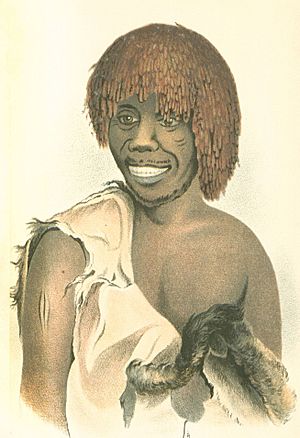Tunnerminnerwait facts for kids
Quick facts for kids
Tunnerminnerwait
|
|
|---|---|
 |
|
| Born | c. 1812 Robbins Island (Tasmania), Australia
|
| Died | 20 January 1842 (aged 29–30) Port Phillip, Australia
|
| Resting place | Queen Victoria Market |
| Other names | Peevay, Jack of Cape Grim, Tunninerpareway, Jack Napoleon Tarrapurrura |
| Known for | Aboriginal freedom fighter |
Tunnerminnerwait (born around 1812, died 1842) was an Australian Aboriginal freedom fighter. He belonged to the Parperloihener clan from Tasmania. People knew him by other names too, like Peevay and Jack of Cape Grim. He was also called Jack Napoleon Tarraparrura by George Robinson.
Contents
Tunnerminnerwait's Early Life
Tunnerminnerwait was born on Robbins Island in Tasmania in 1812. His father was Keeghernewboyheener. Tunnerminnerwait was part of the Parperloihener clan, which was a group within the North West nation of Tasmania. His name means "waterbird."
He spoke English well and was about 171 cm (5'8") tall. His wife was Planobeena, also known as Fanny. She was the sister of another Aboriginal leader, Eumarrah.
Meeting European Settlers
Tunnerminnerwait grew up in Tasmania, which was the second place in Australia where Europeans settled. Over time, the relationship between the Aboriginal people and the settlers became very difficult. There were many attacks and sad events.
One of the first massacres of Tasmanian Aboriginal people happened in 1804 at Risdon Cove. Troops shot at a group that included women and children. By 1806, fights between Aboriginal people and settlers were common. The Cape Grim massacre took place on February 10, 1828. A historian named Professor Lyndall Ryan said that Tunnerminnerwait saw the Cape Grim massacre when he was about 11 years old. Many of his people were killed, and his family was deeply affected.
Tunnerminnerwait first met George Augustus Robinson in June 1830. Robinson was a government official who worked to protect Aboriginal people. Tunnerminnerwait worked for Robinson as a guide on trips around Tasmania from 1830 to 1835. In 1835, Tunnerminnerwait went with Robinson to Flinders Island. This island was a settlement where the remaining Aboriginal people were sent. Robinson described Tunnerminnerwait as a "willing and hardworking young man." He said Tunnerminnerwait was "strong and well made" and did his work as well as any white man. A painting of Tunnerminnerwait was made by the artist Thomas Bock between 1831 and 1835.
Moving to the Mainland
In 1839, George Robinson brought Tunnerminnerwait and Planobeena to Melbourne. They were among sixteen Tasmanian Aboriginal people who came. Robinson hoped they would help teach the Aboriginal people in Victoria about European ways.
Tunnerminnerwait went with George Robinson on a long trip through the Western District from March to August 1841. During this trip, they collected stories about violence between settlers and Aboriginal people. They also looked into the Convincing Ground massacre. In this event, many members of the Gunditjmara clan were killed by whale-hunters. After returning from the trip, Tunnerminnerwait and four others left Melbourne.
Standing Up to Settlers
In September 1841, Tunnerminnerwait (Peevay), Planobeena (Fanny), and three others, including Truganini, began an eight-week fight against the European settlement. They took two guns and some bullets from a settler's hut. Over the next seven weeks, they took things from farms around Melbourne. They injured four white men and caused the deaths of two others.
It took three military groups to find and capture them. Native police helped in the search. All five were captured in November 1841.
Trial and Outcome
On December 20, 1841, they appeared before Judge Willis in Melbourne. They were accused of causing the deaths. Redmond Barry defended them. He was the lawyer who usually defended Aboriginal people. Barry questioned if the British government had the right to judge Aboriginal people, as they were not citizens. He also said the evidence was not strong. None of the five people were allowed to speak in court.
The Supreme Court found Tunnerminnerwait and Timme guilty of causing the deaths of two whalers. Tunnerminnerwait was reported to have said that after he died, he would join his father in Tasmania and hunt kangaroos.
Death
Tunnerminnerwait and Timme were put to death on January 20, 1842. These were the first public executions in the area that would become Melbourne.
Tunnerminnerwait and Maulboyheenner were later buried in a grave that was not marked. This spot is now where the Queen Victoria Market stands.
Memorials
- In 2008, a group called the Tunnerminnerwait and Maulboyheenner Commemoration Committee was formed. They hold a yearly event to remember these men at the place where they were put to death.
- There is a public marker for Tunnerminnerwait and Maulboyheenner. It is located at the site of the Old Melbourne Gaol. This marker helps people remember their story.
See also
- Australian frontier wars
- Black War
- Pemulwuy, an Indigenous Australian leader who fought against settlers.
- Tarenorerer, also known as Walyer, a rebel leader of the Indigenous Australians in Tasmania.


